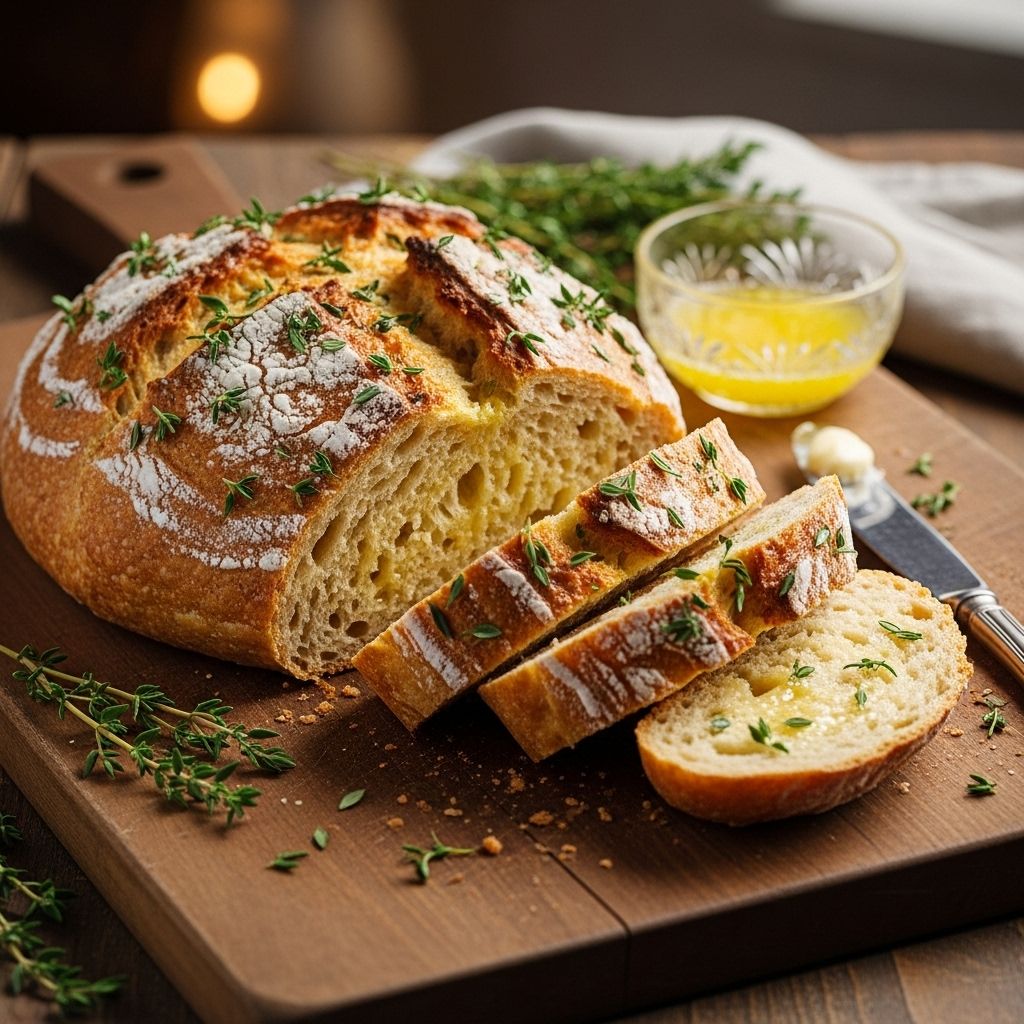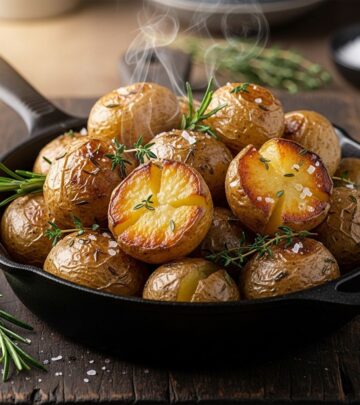Buttery Thyme Bread Recipe: Simple Yet Spectacular
A foolproof loaf that elevates pantry staples into an indulgent centerpiece.

When you think of show-stopping bread recipes, you might imagine complex procedures involving multiple rises, intricate kneading techniques, and hours of preparation. However, sometimes the most memorable dishes come from the simplest ingredients combined with perfect technique. The Pioneer Woman’s Buttery Thyme Bread is exactly that – a deceptively simple recipe that delivers extraordinary results.
The Magic Behind the Simplicity
What makes this bread so special isn’t complexity – it’s the brilliant use of just three ingredients and one crucial technique. This recipe, affectionately known to close friends as “Ridiculously Obscene Bread” due to its generous butter content, proves that sometimes the best culinary experiences come from embracing indulgence rather than restraint.
The beauty of this recipe lies in its accessibility. You don’t need specialized equipment, exotic ingredients, or advanced baking skills. What you do need is quality ingredients, attention to detail, and the willingness to trust the process – especially when it comes to the amount of butter involved.
Essential Ingredients for Perfect Results
The ingredient list for this bread is refreshingly short, but each component plays a crucial role in the final product:
French Bread Selection
The foundation of this recipe is a good quality French bread loaf. Store-bought bread works perfectly fine – in fact, it’s preferred for this recipe. Look for a loaf with a crispy crust and airy interior. The bread should be fresh but not too soft, as it needs to hold up to the generous butter application and high-heat cooking process.
The Butter Component
Two full sticks of salted butter form the heart of this recipe. The butter must be salted – this isn’t optional. Unsalted butter will result in a bland final product that doesn’t deliver the intended flavor impact. The butter should be softened to room temperature but not melted. This consistency allows for even spreading without tearing the bread’s surface.
Fresh Thyme Enhancement
Fresh thyme sprigs provide the aromatic finish that elevates this bread from simple buttered bread to something truly special. The amount can be adjusted to personal preference, but don’t be too conservative – the herb’s earthy, slightly minty flavor complements the rich butter beautifully.
Preparation Technique: Where Magic Happens
The preparation method is where this simple recipe transforms into something extraordinary. Every step, while straightforward, contributes to the final result’s success.
Initial Setup
Begin by preheating your oven to 350°F (175°C). This moderate temperature ensures the butter has time to penetrate the bread before the surface browns. Slice your French bread loaf lengthwise, creating two equal halves. This maximizes the surface area for butter application and ensures even cooking.
The Butter Application Process
Here’s where many home cooks hesitate, but commitment to the process is essential. Apply one full stick of softened butter to each bread half. Yes, that’s two sticks total for one loaf. The key is achieving complete coverage – every millimeter of the bread’s surface should be coated with butter.
Work methodically, spreading the butter evenly across the entire surface. The butter layer should be generous but smooth. Any uncovered areas will result in uneven browning and missed opportunities for flavor development. Take your time with this step; it’s the foundation of the recipe’s success.
The Baking Process: Timing and Technique
The baking process involves two distinct phases, each serving a specific purpose in developing the bread’s final character.
Initial Baking Phase
Place the prepared bread halves on a cookie sheet and bake for 10-15 minutes at 350°F. During this phase, watch for the butter to melt completely and begin soaking into the bread. The surface should start showing signs of gentle browning, but the real transformation is yet to come.
The Broiling Phase
After the initial baking, switch your oven to broil and continue cooking for 3-5 minutes. This step requires constant attention – you’re looking for the butter to develop a deep brown color with some areas approaching black. This might seem excessive, but it’s crucial for flavor development.
The browning process creates complex flavors through the Maillard reaction. The butter transforms from simple fat into a nutty, complex flavoring agent. Don’t be afraid of darker browning – this is where the magic happens. However, maintain vigilance to prevent burning beyond the desired level.
Herb Application and Final Assembly
Once the bread achieves the perfect level of browning, it’s time for the final enhancement. Remove the bread from the oven and immediately sprinkle fresh thyme over the surface. The residual heat will release the herb’s essential oils, creating an aromatic finish that complements the rich, nutty butter flavor.
The amount of thyme can be adjusted to taste, but don’t be overly conservative. The herb should be visible across the surface and provide aromatic interest in every bite. Some cooks enjoy experimenting with herb combinations – parsley, sage, rosemary, and thyme work beautifully together for a more complex flavor profile.
Serving Suggestions and Presentation
Proper serving enhances the dining experience and ensures everyone gets to enjoy this special bread at its peak.
Cutting and Portioning
Cut the bread into 1-inch strips while still warm. The rich nature of this bread means smaller portions are often preferred – the intense butter and herb flavors are satisfying in modest amounts. Use a sharp knife to ensure clean cuts that don’t compress the bread’s texture.
Presentation Options
This bread works well in various presentation styles:
- Arranged in a rustic bread basket lined with cloth napkins
- Displayed on a wooden cutting board for casual dining
- Presented on an elegant platter for formal occasions
- Served alongside soups, salads, or as an appetizer course
Nutritional Considerations and Modifications
While this bread is undeniably rich, understanding its nutritional profile can help with meal planning and portion control.
Caloric Content
Due to the generous butter content, this bread is calorie-dense. Each serving provides significant amounts of saturated fat and calories. This makes it perfect for special occasions or when you want to create a memorable dining experience.
Possible Modifications
While maintaining the recipe’s integrity is important for achieving the intended results, some modifications are possible:
- Herb variations can include rosemary, oregano, or sage
- A light sprinkle of garlic powder can add depth
- Sea salt flakes can enhance the overall flavor profile
- Different bread types can be experimented with, though results may vary
Storage and Reheating Guidelines
While this bread is best enjoyed fresh and warm, proper storage and reheating can extend its enjoyment.
Short-term Storage
Leftover bread can be wrapped in aluminum foil and stored at room temperature for up to 24 hours. For longer storage, refrigeration is recommended, though this may affect texture.
Reheating Methods
To restore the bread’s appeal, reheat in a 350°F oven for 5-7 minutes, or until warmed through. Avoid microwave reheating, which can make the bread soggy and diminish the crispy texture that makes this recipe special.
Troubleshooting Common Issues
Even with a simple recipe, certain issues can arise. Understanding how to address them ensures consistent success.
Butter Not Browning Properly
If the butter isn’t achieving the desired brown color, increase broiling time while maintaining close supervision. Oven variations can affect browning rates, so adjust timing accordingly.
Uneven Browning
Uneven butter application typically causes this issue. Ensure complete surface coverage during the butter spreading phase for consistent results.
Bread Becoming Too Crispy
Overbaking can result in overly crispy bread. Monitor closely during both baking phases and adjust timing based on your oven’s characteristics.
Frequently Asked Questions
Q: Can I use unsalted butter instead of salted butter?
A: While technically possible, salted butter is strongly recommended for optimal flavor. If using unsalted butter, add a pinch of salt to compensate, though the results won’t be identical.
Q: What other herbs work well with this recipe?
A: Rosemary, sage, oregano, and parsley all work beautifully. You can use single herbs or create combinations based on your preferences and what’s available.
Q: How far in advance can I prepare this bread?
A: This bread is best prepared and served immediately. However, you can prepare it up to 2 hours in advance and reheat briefly before serving.
Q: Can I freeze the prepared bread?
A: Freezing isn’t recommended as it significantly affects texture and flavor. This bread is best enjoyed fresh.
Q: What makes this bread so popular at gatherings?
A: The combination of rich butter flavor, aromatic herbs, and perfect texture creates a memorable experience. The browning process develops complex flavors that elevate simple ingredients into something special.
This Buttery Thyme Bread recipe proves that culinary magic doesn’t always require complexity. Sometimes the most memorable dishes come from perfect execution of simple techniques with quality ingredients. The key is embracing the process fully – from the generous butter application to the careful browning that develops the signature flavor profile that makes this bread truly unforgettable.
References
- https://www.food.com/recipe/the-bread-ree-drummond-pioneer-woman-443582
- https://www.thepioneerwoman.com/food-cooking/recipes/a45550204/herb-focaccia-recipe/
- https://www.thepioneerwoman.com/food-cooking/recipes/a8866/buttery-thyme-bread/
- https://thevollmerfamily.com/MajorMom/2008/01/pws-buttery-thyme-bread.html
- https://www.thepioneerwoman.com/food-cooking/recipes/a9458/the-bread/
- https://www.thepioneerwoman.com/food-cooking/recipes/a9510/buttered-rosemary-rolls/
Read full bio of Sneha Tete












